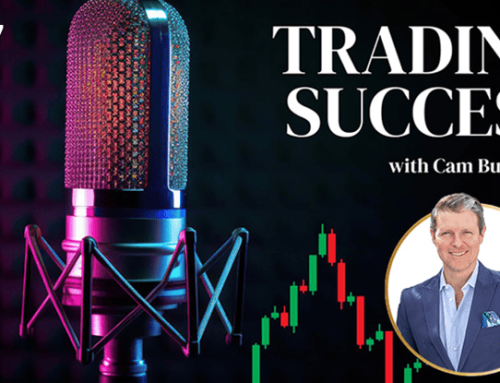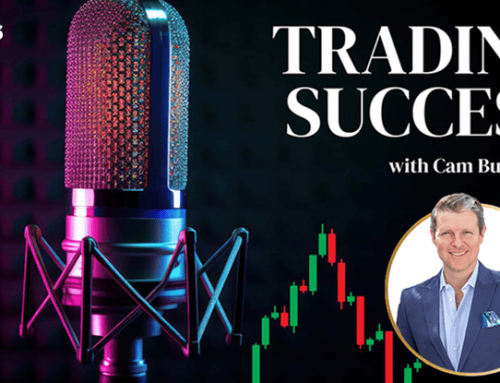What is leverage trading and how does it work? In this post, we’ll cover the good, the bad, and the ugly of leveraged trading and trading leveraged products.
What is Leverage Trading?
Leveraged trading, also known as trading on margin is offered by most major brokers. This type of trading allows a trader to multiply the value of their trades. This means that a trader can open a position with a value more than the funds used to open that position.
Day traders who choose to trade leveraged products do so to seek accelerated returns. The more leverage, the more potential for higher returns, this is popular with traders with a smaller account. The opposite is also true, trading with leverage can lead to large losses. It’s important to have a trading strategy, and excellent day trading risk management techniques when trading leveraged products in volatile markets.
How Does Leverage Trading Work?
To use trading leverage you use borrowed money from your broker allowing you to increase your position size. As the trader you are only required to have the margin available. The margin is a fractional amount of the position size.
Once the trader closes out their position, they must return the borrowed funds to the broker. The trader will then either receive or pay the difference. If the trade is profitable, the trader gets the difference in price, otherwise the trader pays the difference.
This gives traders the ability to open positions of a size not possible using a smaller account. Trading leverage is described as a ratio which indicates the funds utililised against funds borrowed. For example, a ratio of 1:10 would mean that you can leverage each dollar up to 10 times.
Leverage Trading Example
Let’s say that, for this example, your trading leverage is 1:10 and are placing $100 on a trade. You have 10 x the buying power, the value of your trade is now $1,000 (10 x $100).
This trade multiplies potential profits based on the amount of leverage. This trade also multiplies potential losses. In this example, profits are multiplied by 10, as are losses.
For this example, let’s say that the movement in price was $5. If the trader predicted the correct direction for the trade, the profit is 10 x $5 = $50. If the trader picks the wrong direction, then the loss is $50.
On this trade the initial margin (funds needed to place the trade) is $100. Depending on volatility and movement against the trader, this can change. If a trade moves against the trader enough the margin required grows. If the margin required nears the total funds in the account, the trader may receive a margin call.
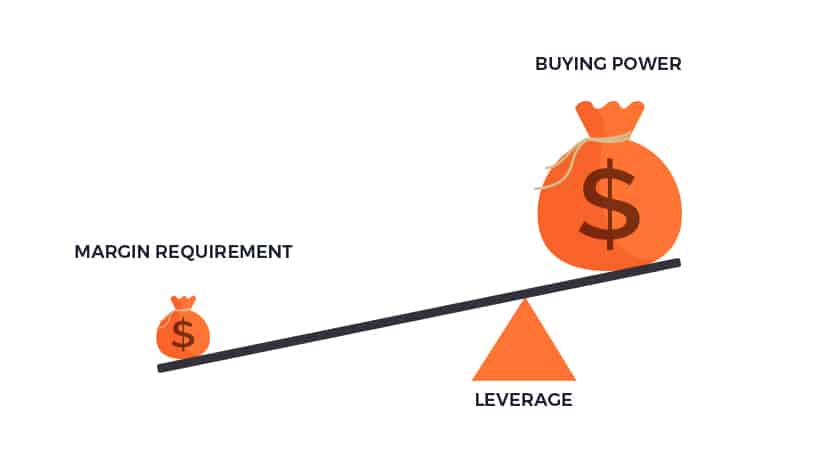
Trading Leveraged Products
A common product used for trading with leverage is a derivatives contract (e.g. Futures). A derivative is a financial instrument that derives its value from an underlying asset or security. Derivatives allow traders to speculate on the movement of an underlying asset. The trader does this without actually owning the asset.
A trader might buy a derivative contract that allows them to bet against the movement of a stock. The trader is able to see a profit or loss without actually owning the stock/asset.
Types of Products For Trading With Leverage
Trading leverage is available on most popular markets. Leverage products include:
| Product | Leverage |
|---|---|
| Options | Up to 40:1 |
| Futures | 90-95% (10% margin) |
| Forex | Up to 30:1 (some brokers offer 100:1) |
| CFDs | 2:1 to 30:1 |
| Cryptocurrencies | 2:1 – 3:1 |
| Some ETFs | 2:1 – 3:1 |
Note the with Futures that the margin required is only 10-15% of the contract’s actual value.
The trading leverage allowed on these markets depends on regulatory limitations and volatility. Brokerages also control the amount of leverage that they offer.
Leverage Trading: The Good
Let’s take a look at some of the benefits of leveraged trading. While there are risks (which we’ll get to shortly) there are also many benefits to leverage trading.
1. More Accessible, Smaller Entry Price:
Trading on margin allows a trader to access products without paying the full price of the asset. This means traders with smaller accounts can still access and trade these products.
2. Increased Profits:
When trading with leverage, you can make much larger profits than you would with a standard trade. The same is true for losses, more on that later.
3. Increased Liquidity:
Leveraged products are typically very liquid, which means you can enter and exit quickly. This is true with the major Futures markets where the volume is large.
4. Increased Flexibility:
With leverage trading, you have more flexibility to trade in a wider range of markets. This is particularly true for trading Futures in Australia as there are many asset classes to choose from
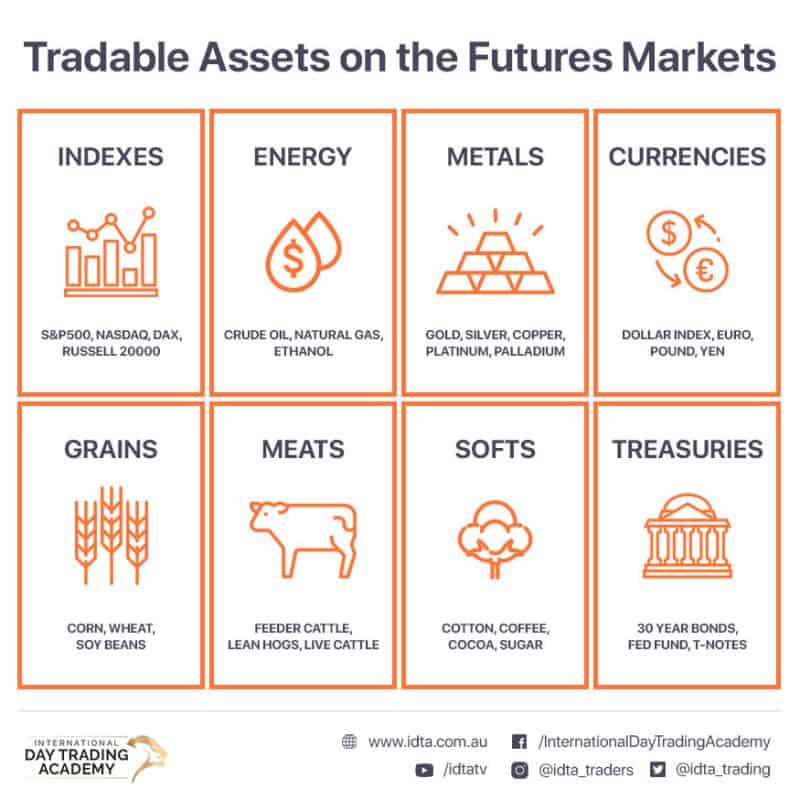
Leverage Trading: The Bad, and Ugly
1. Increased Risk:
Trading leveraged products carries a larger risk than not trading with leverage. The increased size of potential losses means it’s important to track and manage trades.
2. Losses can exceed funds available:
Depending on the broker, you may be liable to pay back your broker should you lose more than your full account. If you are using a 2:1 leverage, your losses would be doubled. That means that if an asset loses more than 50% of its value, you’ll lose more than 100% of the cash you had available to invest.
What are the Risks of Trading Leveraged Products?
Because of the increased risk involved in trading leverage, you need to be a good risk manager. You should always use a stop loss and risk management techniques to avoid massive losses.
A large loss may lead you to receive a ‘margin call’ from your broker. A margin call will be a demand to deposit further funds. This can happen because your broker worries about your ability to repay your debt if your investments continue to lose value.
Some brokerages will provide negative balance protection. This means that you will be exited from a trade rather than go into the minus.
If the broker doesn’t offer this, risk is technically unlimited. If ill managed, you could end up owing your broker money.
Reduce the Risk of Trading Leveraged Products
To reduce the risk of trading leveraged products, first limit the size of the leverage you use. While trading leverage adds more bang for your buck, so to speak, the greater the leverage the greater the risk.
Use a Stop loss:
You should also trade using a stop loss for every trade you place. This will ensure that you control the maximum amount of money at risk each time you trade. Because there is limitless risk with leverage trading, it’s important to manually add that limit.
Have a maximum risk allowance:
Have an initial risk in mind before placing the trade, this forms the stop loss. I choose to use the rule of no more than 2% of my account size per trade. If my technical analysis on a trade says my stop needs to be more than 2%, I don’t take the trade as it is too risky for me.
Make your reward to risk in your favour:
You should always have a risk reward ratio of 1:1 or better. 1:1 means that your reward is equal to your risk. I usually look to have my reward to risk at 2:1 as it is a good balance between achievable and maintainable.
If I have my reward to risk at 1:1, I need to have a win rate above 50%. If all my trades are 2:1 then I can be profitable around the 40% mark. It might sound like making the reward much, much bigger than the risk means you rarely need to be right. While you can be correct less often, it is much harder to be correct.
Make your position sizes appropriate:
You should only open a position if it is allowed within your risk limitations. Leveraged trading can be risky and a larger position can compound out of control. Trading is about accumulation, not about getting rich quick.
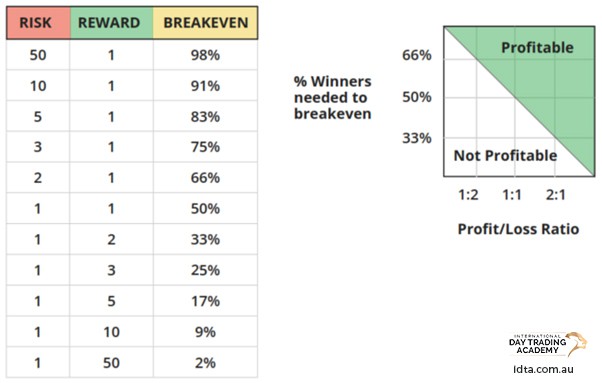
How to Start Trading Leveraged Products
You should follow these steps before you take up leveraged trading. Because of the risks involved you need to have the knowledge, skills, and experience to be consistent.
Learn a Trading Strategy
The best way to learn a trading strategy is to learn to trade from an academy or a professional trader. It’s possible to learn from sources on the internet, but beware of conflicting information. Learning from various sources doesn’t provide context. Without context you may use that information in the wrong way.
A trading strategy helps find high-probability trades, but also provides risk management tools. A robust strategy will not only tell you when to enter a trade, but also when to exit, which is important.
Find a Broker or Trading Platform
To be able to trade you will need access to a trading platform, and a means of executing orders. You can do this via a broker, they often provide the platform. You can also access the Futures markets directly through a platform like NinjaTrader.
Practise on a Simulated Account
Before you dive straight in, you need to practise your trading on an account that doesn’t hold real money. Even after learning a strategy inside out, it’s important to gain real life experience.
Practicing on a simulation account will allow you to gain live market experience without risking your own money and is the best way to learn day trading. Once you have proven to yourself that you can be consistently profitable you can trade live.
Start Trading
Once you start live trading you need to ensure that you aren’t trading with too much leverage. You need to be mindful of risk management. Because leverage trading is risky you should start out slow and build your way up as your confidence grows.
Leverage Trading Australia
Leverage trading is a risky proposition that can lead to large losses if not done correctly. Be mindful of risk management
When it comes to leveraged trading, there are definitely good and bad aspects to consider. Make sure you weigh the pros and cons before deciding if leveraged trading is right for you.
If you’re interested in learning more about leverage trading, check out our next free trading class.

![What is Leverage Trading? [The Good, Bad, and Ugly] 1 leverage trading - pros and cons of trading leveraged products](https://idta.com.au/wp-content/uploads/2022/03/leverage-trading-pros-and-cons-of-trading-leveraged-products.jpg)
![What is Leverage Trading? [The Good, Bad, and Ugly] 5 Free day trading web class](https://idta.com.au/wp-content/uploads/2020/08/free-day-trading-web-class.png)

